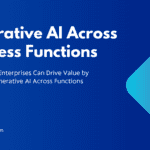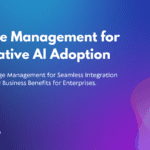In the ever-evolving landscape of digital transformation, the emergence of Generative AI stands as a beacon of innovation, promising to revolutionize workflows, optimize decision-making, and drive unprecedented value across industries. As organizations embark on their Generative AI journey, it becomes increasingly imperative for leaders to navigate this complex terrain with precision, foresight, and a nuanced understanding of the multifaceted challenges and opportunities that lie ahead. Generative AI for Leaders is not just about adopting new technology; it’s about reshaping organizational strategies to harness its full potential effectively.
Understanding the Generative AI Landscape
At the nexus of technological advancement and organizational strategy lies the realm of Generative AI, where the convergence of data science, machine learning, and computational linguistics fuels the creation of intelligent systems capable of generating human-like outputs. Whether it’s automating repetitive tasks, generating creative content, or predicting market trends, the applications of Generative AI span a vast spectrum, offering organizations a myriad of possibilities to enhance efficiency, drive innovation, and gain a competitive edge in an increasingly digitized world.
Generative AI for Leaders in Enterprises
As enterprises across the globe look to harness the transformative power of generative artificial intelligence, the role of leadership becomes increasingly critical. Generative AI for Leaders in enterprises involves more than just adopting cutting-edge technology; it requires a comprehensive strategy that aligns with organizational goals, addresses specific industry challenges, and fosters an environment conducive to innovation. Leaders must be prepared to guide their organizations through this technological evolution, ensuring that the integration of GenAI not only enhances operational efficiency but also drives strategic growth and competitive advantage. Let’s dive deeper.
1. Innovate in Your Industry: Pioneering the Path of Transformation
Innovation lies at the heart of Generative AI adoption, propelling organizations towards the forefront of industry disruption and technological advancement. Leaders are tasked with identifying bespoke use cases within their respective sectors, envisioning novel applications of Generative AI that address specific pain points, capitalize on emerging trends, and unlock untapped opportunities for growth. By fostering a culture of experimentation, collaboration, and forward-thinking, organizations can harness the full potential of Generative AI to reimagine business processes, redefine customer experiences, and shape the future of their industries.
2. Protect Data with Confidence: Safeguarding the Pillars of Trust
As organizations embark on their Generative AI journey, the sanctity of data emerges as a cornerstone of success, underpinning the foundation of trust and integrity upon which sustainable growth is built. Leaders must prioritize the implementation of robust data protection measures, ensuring the confidentiality, integrity, and availability of sensitive information in an increasingly interconnected digital ecosystem. From encryption protocols and access controls to data anonymization and privacy-enhancing technologies, organizations must adopt a multi-layered approach to data security, mitigating the risks of breaches, unauthorized access, and regulatory non-compliance that loom ominously in the digital horizon.
3. Manage Risk and Defend Privacy: Navigating the Ethical Quagmire
In the realm of Generative AI, the specter of risk lurks ominously, casting a shadow of uncertainty over the promises of innovation and progress. Leaders must navigate this treacherous terrain with vigilance and foresight, proactively identifying potential threats, vulnerabilities, and ethical dilemmas that may arise from the deployment of AI-driven systems. From algorithmic bias and data poisoning to adversarial attacks and unintended consequences, the landscape of AI ethics is fraught with peril, requiring organizations to develop comprehensive risk management strategies, ethical frameworks, and governance mechanisms that uphold the principles of fairness, transparency, and accountability in the pursuit of AI-driven innovation.
4. Invigorate Your Digital Core: Fortifying the Foundations of Transformation
As the digital landscape continues to evolve at breakneck speed, organizations must fortify their digital core to withstand the winds of change and seize the opportunities of tomorrow. Leaders are tasked with modernizing their technology infrastructure, systems, and tools, embracing agile methodologies, cloud-native architectures, and DevOps practices to foster agility, scalability, and resilience in an increasingly dynamic and interconnected world. From legacy system modernization and API-driven integration to microservices architecture and serverless computing, the journey towards digital transformation demands a holistic approach that transcends mere technological prowess, encompassing cultural change, organizational agility, and strategic alignment across all facets of the enterprise.
5. Tap the Human Element of AI: Cultivating a Culture of Collaboration
Amidst the clamor of technological innovation and digital disruption, the human element remains the beating heart of organizational success, anchoring the voyage of transformation with empathy, creativity, and ingenuity. Leaders must recognize the symbiotic relationship between humans and machines, fostering a culture of collaboration, learning, and adaptability that empowers employees to thrive in an AI-enabled world. From reskilling and upskilling initiatives to fostering interdisciplinary collaboration and cross-functional teamwork, organizations must invest in the human capital that fuels the engine of innovation, unlocking the full potential of Generative AI while nurturing a workforce that is agile, resilient, and empowered to navigate the complexities of the digital age with confidence and conviction.
Conclusion: Charting a Course for Success in the Age of Generative AI
In conclusion, the integration of Generative AI represents a seminal moment in the annals of human history, heralding a new era of innovation, disruption, and transformation on a scale unprecedented in scope and magnitude. As organizations embark on their Generative AI journey, leaders must navigate this uncharted terrain with courage, vision, and humility, charting a course that transcends the boundaries of convention, embraces the possibilities of tomorrow, and empowers humanity to realize its fullest potential in the pursuit of a brighter, more inclusive, and prosperous future for all. Generative AI for Leaders is not merely about technological adoption but about steering organizations towards a future where AI augments human capabilities and fosters a culture of continuous improvement and innovation.



